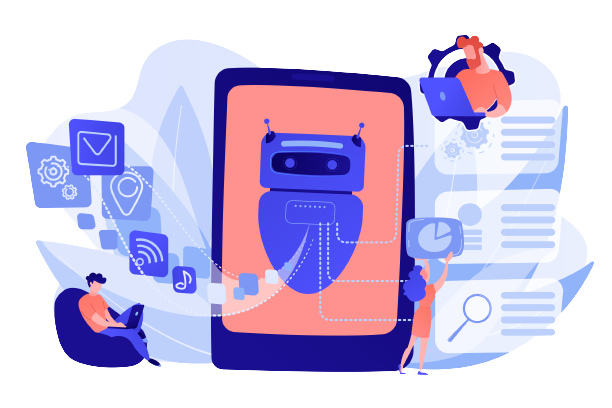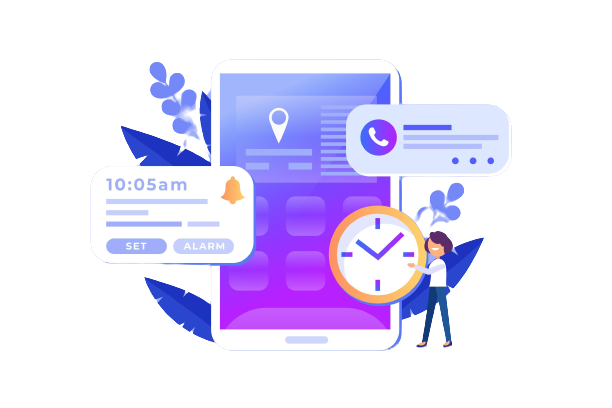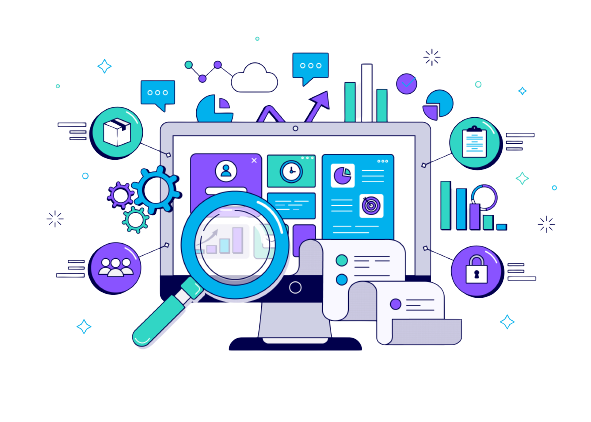
Today, mastering the art of timing in CRM automation can be a revolutionary step for businesses. Sending automated messages at the right moment can significantly impact customer engagement, conversion rates, and overall satisfaction. In this blog, we’ll get deep into the science and strategies of omnichannel communication in CRM automation.
The Science of Perfect Timing: Optimizing Automated Messages in CRM
Timing is not just an art; it’s a science too. To optimize your automated message communication in CRM, you need to understand the underlying principles of timing. Here’s what you need to know:
- Circadian Rhythms and Engagement Peaks: The human body has natural rhythms that affect behavior. Learn how to align your message delivery with these rhythms to boost open rates and responses.
- Days of the Week and Time of Day: Explore data-backed insights into which days and times are most effective for sending automated messages in different industries. Discover the sweet spots for maximum impact.
- Seasonal Variations: Understand how seasons and holidays can influence consumer behavior and buying patterns. Tailor your omnichannel communication calendar accordingly for optimal results.
Understanding Customer Behavior: Key Insights for Timing Automated Messages

Your customers leave digital footprints that reveal a treasure trove of information about their preferences and behaviors. Here’s how to use this omnichannel communication data to your advantage:
- Customer Journey Mapping: Map out your customer’s journey to identify critical touchpoints. Learn when customers are most receptive to messages and how to time them for the highest impact.
- Behavioral Triggers: Explore how customer actions, such as website visits, cart abandonment, or previous purchases, can trigger automated messages. Learn how to set up triggers that align with your customer’s behavior.
- Segmentation for Timing: Not all customers are the same. Discover the power of segmentation and how it can help you deliver timely and relevant messages to different customer groups.
Choosing the Right Moments: When to Trigger Automated Messages in CRM
Timing is everything, but it’s not one-size-fits-all. Different messages require different triggers and moments for maximum effectiveness:
- Onboarding and Welcome Messages: Learn how to make a great first impression by sending welcome messages at the perfect moment. This omnichannel communication will ensure that new customers feel valued from the start.
- Abandoned Cart Recovery: Dive into the art of cart abandonment emails and how to send them at just the right moment to entice customers back to complete their purchase.
- Re-engagement Campaigns: Discover when it’s time to win back dormant customers with re-engagement campaigns. Understand the signs of disengagement and how to time your messages accordingly.
- Post-Purchase Communication: Explore post-purchase messaging, including order updates, cross-selling, and feedback requests. Find out when and how to send these messages for improved customer satisfaction and loyalty.
By mastering the science of omnichannel communication, timing, understanding customer behavior, and choosing the right moments for automated messages in CRM, you can enhance customer engagement, drive conversions, and ultimately build stronger and more profitable customer relationships.
Personalization and Segmentation in CRM Messaging

It’s no secret that personalized and segmented communication can significantly impact the success of your CRM messaging campaigns. Customers expect content that resonates with their needs and interests, and businesses that deliver on these expectations tend to thrive. Let’s discuss and learn more about the art of personalization and segmentation in CRM messaging.
Tailoring Messages to the Individual: Personalization Techniques in CRM Automation
Personalization is more than just using someone’s first name in an email; it’s about crafting messages that speak directly to the recipient’s preferences, behaviors, and needs. Here, we’ll explore various personalization techniques within CRM automation:
- Customer Profiling: Creating detailed customer profiles based on their demographics, behaviors, and interactions with your brand is the foundation of effective personalization. Learn how to gather and utilize this data.
- Behavioral Tracking: Discover how tracking and analyzing user behavior on your website and other digital touchpoints can help you send personalized messages triggered by specific actions or interests.
- Predictive Analytics: Harness the power of predictive analytics to anticipate customer needs and preferences, enabling you to send proactive, personalized messages that resonate with recipients.
- A/B Testing: Understand how A/B testing can help you refine your personalization efforts by experimenting with different content, subject lines, and messaging styles to see what resonates best with each segment.
Segmentation Strategies for Effective Timing in CRM Automated Messages
Timing is crucial in CRM messaging. Sending the right message at the wrong time can lead to missed opportunities or even customer irritation. Here, we’ll discuss segmentation strategies to ensure your messages are timed effectively:
- Demographic Segmentation: Explore how dividing your audience by demographics such as age, gender, location, and income level can help you send messages at times that align with their daily routines and preferences.
- Behavior-Based Segmentation: Dive into the world of behavioral segmentation, where you categorize customers based on their past interactions with your brand. Discover how this can guide the timing of follow-up messages or recommendations.
- Purchase History: Learn how analyzing a customer’s purchase history can help you send timely messages about product updates, complementary items, or even replenishment reminders.
- Engagement Metrics: Explore how measuring engagement metrics, such as email open rates and click-through rates, can guide when to send follow-up messages or re-engagement campaigns.
Dynamic Content: A Tool for Timely and Relevant CRM Messaging

Dynamic content allows you to send messages that adapt to the recipient’s behavior or profile in real time. Here, we’ll uncover how dynamic content can elevate your CRM messaging:
- Personalized Product Recommendations: Discover how to use dynamic content to showcase product recommendations based on a customer’s browsing or purchase history, increasing the likelihood of conversion.
- Location-Based Content: Explore the benefits of sending location-specific content, such as store promotions or event invitations, to enhance customer engagement and drive foot traffic.
- Countdown Timers and Urgency Messaging: Learn how to create a sense of urgency with dynamic countdown timers in emails, reminding customers of limited-time offers or expiring discounts.
- Tailored Newsletters: Find out how to use dynamic content to craft newsletters that cater to each recipient’s interests, ensuring they receive only the content that matters most to them.
By mastering personalization techniques, segmentation strategies, and the use of dynamic content in your CRM messaging, you’ll not only improve customer engagement but also increase conversion rates and successfully make lasting relationships with your audience.
Scheduling Strategies for Automated CRM Messages: Dos and Don’ts
The ability to send automated messages to your customers at the right moment can significantly impact your marketing and customer engagement efforts. However, it’s not just about sending messages; it’s about sending them at the right time and in the right way. Here, we’ll explore some best practices for scheduling automated CRM messages, including the dos and don’ts.
The Dos:
- Segment Your Audience: Before sending automated CRM messages, segment your audience based on their preferences, behavior, and demographics. This allows you to tailor your messages and timing to specific groups, increasing the relevance and effectiveness of your campaigns.
- Leverage Customer Data: Use customer data to inform your timing decisions. Analyze past interactions, purchase history, and engagement patterns to identify the best times to send messages to different segments of your audience.
- Test and Iterate: A/B testing is your ally. Experiment with different sending times and frequencies to determine what works best for your audience. Continuously analyze the results and adjust your scheduling accordingly.
- Utilize Personalization: Personalize your messages to make them more relevant to each recipient. Address customers by name and tailor content based on their previous interactions, preferences, and behaviors.
- Consider the Customer’s Journey: Map out the customer journey and align your message scheduling with key touchpoints. Send messages that guide customers through the journey, providing valuable content and offers at each stage.
The Don’ts:
- Overload Your Audience: Avoid bombarding your audience with too many messages. Overloading can lead to unsubscribes or customers ignoring your messages. Be mindful of frequency.
- Ignore Time Zones: Ignoring time zones can result in messages being sent at inconvenient times for recipients. Use automation tools that account for time zone differences to ensure messages are delivered at appropriate times.
- Send Messages at Odd Hours: Avoid sending messages late at night or during the early hours of the morning unless you have data indicating that it’s when your audience is most active and receptive.
- Rely Solely on Automation: While automation is powerful, don’t forget the human touch. Some messages, such as personalized follow-ups or responses to customer inquiries, may require a more immediate, manual response.
Time Zones Matter: Global Considerations in CRM Message Timing

In this interconnected world, businesses often operate on a global scale. This means that your customer base may span multiple time zones. When it comes to scheduling automated CRM messages, understanding and respecting these time zone differences is crucial. Here’s what you need to know:
- Segment by Time Zone: If your customer base spans multiple time zones, segment your audience accordingly. Send messages at times that are convenient for each time zone to ensure that no one is receiving messages in the middle of the night.
- Automate Time Zone Adjustments: Use CRM automation tools that can automatically adjust the sending time based on the recipient’s time zone. This ensures that your messages are received when they are most likely to be read.
- Consider Local Holidays: Be aware of local holidays and observances in different regions. Avoid sending messages on holidays when your audience may not be actively engaging with their emails or messages.
- Test for Optimal Timing: Conduct A/B tests to determine the best times to send messages in different time zones. These tests can provide valuable insights into when your audience is most responsive.
By considering global time zone differences and tailoring your message scheduling accordingly, you can enhance the effectiveness of your CRM automation and improve customer engagement across regions.
Automated Drip Campaigns: Sequencing Messages for Optimal Timing
Automated drip campaigns are a powerful tool for nurturing leads and guiding customers through the sales funnel. These campaigns involve sending a series of pre-scheduled messages to prospects or customers at specific intervals. Here are some key considerations for optimizing the timing of your automated drip campaigns:
- Define Your Drip Sequence: Determine the sequence of messages in your drip campaign. Consider the logical progression of content and offers that will lead recipients toward a desired action, such as making a purchase.
- Set Clear Timing Intervals: Establish clear timing intervals between each message in the drip sequence. These intervals can vary depending on the nature of your campaign and the customer’s position in the sales funnel.
- Consider Engagement Levels: Monitor recipient engagement with your messages. If a recipient engages with one message, adjust the timing of the next message accordingly. For instance, if they open an email, you may want to send the next message sooner.
- Segment Your Audience: Segment your audience based on their behavior and response to previous messages. This allows you to send more relevant messages at the right time. For example, send follow-up messages with special offers to those who have shown interest but haven’t converted.
- Test and Refine: Continuously test and refine your drip campaigns. Analyze the results and adjust the timing and content based on what works best to achieve your campaign goals.
- Avoid Overloading: Be cautious not to overload recipients with too many messages in a short period. Respect their inbox and pacing preferences.
Automated drip campaigns, when executed with careful consideration of timing and sequencing, can nurture leads effectively and guide customers toward conversion, making them a valuable asset in your CRM strategy.
CRM Automation Platforms: Features for Timing Optimization

CRM automation platforms are powerful tools that enable businesses to streamline their customer relationship management processes, including message timing. Let;s explore the features and functionalities that these platforms offer for optimizing the timing of automated messages.
- Scheduled Messaging: Most CRM automation platforms allow you to schedule messages to be sent at specific times or dates. This feature is invaluable for ensuring that your messages reach your audience at the most opportune moments. You can align your messaging with peak engagement times or customer preferences.
- Trigger-Based Messaging: Trigger-based messaging is a sophisticated feature that allows you to send messages in response to specific customer actions or events. For example, you can set up triggers to send a follow-up email after a customer makes a purchase or abandons a shopping cart. This capability ensures that your messages are not only timely but also highly relevant.
- Segmentation and Personalization: Effective timing often goes hand-in-hand with personalized messaging. CRM automation platforms offer robust segmentation tools that help you divide your audience into distinct groups based on various criteria, such as demographics, behavior, or purchase history. With these segments, you can tailor your messages and their timing to suit each group’s preferences and needs.
- A/B Testing: A/B testing allows you to experiment with different timing strategies to identify what works best for your audience. You can test variations in the timing of messages and analyze which timing options yield higher open rates, click-through rates, and conversions. CRM platforms often provide built-in A/B testing capabilities to simplify this process.
- Analytics and Insights: To optimize message timing effectively, you need data-driven insights. CRM automation platforms typically offer advanced analytics tools that track the performance of your messages. You can monitor when recipients open emails, click on links, or take other desired actions. This data can inform your timing decisions and help you refine your strategies over time.
- Multi-Channel Integration: In today’s multi-channel marketing landscape, coordinating message timing across various platforms is crucial. CRM automation platforms often integrate with email marketing, social media, SMS, and other communication channels. This integration allows you to maintain consistent timing across all touchpoints, enhancing the overall customer experience.
Cross-Channel Messaging: Coordinating Timing Across Platforms

Coordinating message timing across multiple channels is a fundamental aspect of modern marketing and customer engagement. Here, we’ll delve into strategies and considerations for synchronizing timing across various platforms.
- Unified Messaging Strategy: To ensure a seamless customer experience, it’s essential to develop a unified messaging strategy that spans different communication channels. This strategy should include a consistent timing framework that aligns with your brand’s messaging goals.
- Content Consistency: Consistency in messaging content is as crucial as timing. When messages are coordinated across channels, make sure that the content maintains a coherent voice and message, regardless of the platform. This consistency helps reinforce your brand identity.
- Data Sharing and Integration: Effective cross-channel timing relies on data sharing and integration between platforms. CRM automation platforms often offer connectors or APIs that facilitate data exchange between systems. This enables you to have a centralized view of customer interactions and ensures that messages are timed appropriately across channels.
- Customer Journey Mapping: Develop a comprehensive understanding of your customer journey, including the various touchpoints where customers engage with your brand. By mapping this journey, you can identify key moments for messaging across different channels and coordinate timing to enhance the customer experience.
- Real-Time Communication: Some situations may call for real-time communication. For example, if a customer raises an issue on social media, a swift response is crucial. Cross-channel CRM platforms should enable real-time notifications and responses, ensuring timely engagement.
- Marketing Automation Workflows: Implement marketing automation workflows that trigger messages and actions across channels based on customer behavior or predefined conditions. For instance, if a customer opens an email but doesn’t make a purchase, an automated follow-up message can be sent via another channel, like SMS.
- Testing and Optimization: Just as with single-channel strategies, it’s essential to A/B test and optimize timing across multiple channels. What works on one platform may not work on another, so ongoing testing helps refine your cross-channel timing approach.
When implemented thoughtfully, these techniques can significantly enhance customer engagement and drive better results for your business.
Conclusion: Adapting CRM Message Timing with Customer Feedback
In the world of message communication platforms like CRM, timing can make or break your messaging strategy. We’ve explored the significance of listening to customer feedback and making timing adjustments for continuous improvement.
- Your customers are valuable sources of feedback. Actively seek and listen to their insights, especially regarding message timing. Adjust your schedules based on their preferences and routines.
- Use surveys and feedback loops to gather structured data on message timing satisfaction. Identify patterns and tailor your timing accordingly.
- Embrace agile marketing to adapt to evolving customer preferences. Experiment, analyze, and refine your timing strategies. Remember, one size doesn’t fit all; customize timing for different customer segments.
Customer feedback is crucial for optimizing CRM message timing. By listening, using surveys, and staying agile, you can fine-tune your timing for improved engagement and customer satisfaction. The journey to timing mastery is ongoing but rewarding.